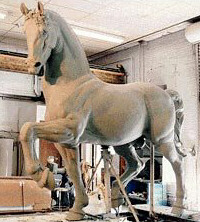Fine Art Touch | Exploring Italian Renaissance Art > The Life of Leonardo da Vinci > Leonardo's Bronze Horse Sculpture Leonardo's Great Bronze Horse Sculpture
Italian artists like Verrocchio and Leonardo would surely have seen the monumental bronze horse sculpture of the Roman Emperor, Marcus Aurelius, in the heart of Rome, the centerpiece of St. Peter’s piazza. This equestrian sculpture and the equestrian sculpture of Colleoni surely later inspired Leonardo to propose the construction of a 24-foot high, bronze horse sculpture for Ludovico Sforza, Duke of Milan in 1483. In preparation for casting Leonardo's Great Bronze Horse sculpture, the artist constructed a full-scale clay model which was destroyed by war.
Brenda Harness, Art Historian | ||||||||
|
|
Welcome to |
| Click here to sign up for our newsletter. |
| We respect your privacy and we will never sell your name or email address to another party. |
ART SALE We paint any size,
CLICK HERE!
any image. Click
HERE to contact us.
|
Mother and Child |
| SPECIAL SALE PRICE! |
Buy great
art books
at Amazon!
Home Art Reproductions Unique Gifts Other News in Art Italian Renaissance Art Trecento (Proto-Renaissance) Early Renaissance High Renaissance Mannerism Published Articles Glossary of Terms Contact Us About Us Site Map


